Experimental Investigation of the Influence of Freeze–Thaw Mode on Damage Characteristics of Sandstone
Abstract
1. Introduction
2. Experimental Scheme
2.1. Sample Preparation
2.2. Freeze–Thaw Modes and Conditions
3. Results
3.1. Apparent Morphology
3.2. Open Porosity
3.3. Wave Velocity
3.4. Surface Hardness
3.5. Uniaxial Compressive Strength
3.6. Relationship between Weathering Index and UCS
4. Evaluation of Damage Degree
5. Conclusions
- (1)
- The environment of rocks is an important prerequisite for weathering protection. The damage characteristics of rock samples caused by different freeze–thaw modes are quite different on the macro level. The damage to sandstone is the most serious under the action of immersion freeze–thaw, and the overall damage of some rock samples occurs within 80 cycles. The damage caused by periodic saturated freeze–thaw is the next most serious. Capillary freeze–thaw damage is the least significant, and it is significant only in the range of 2 mm at the bottom.
- (2)
- The change in the testing environment affects the water content of the rock, leading to a certain difference in the test results of wave velocity. As the curve change rates of wave velocity and the number of freeze–thaw cycles are different in different testing environments, attention should be paid to this difference in on-site nondestructive testing.
- (3)
- As the number of freeze–thaw cycles increased, the UCS of sandstone showed a decreasing trend of first fast and then slow, while the strength loss rate shows a rising trend of first fast and then slow, both of which show a good exponential relationship with the number of freeze–thaw cycles. In the early stage, the strength loss increases rapidly. After 20 cycles, the strength attenuation accounts for about 60% of the total attenuation value of 80 cycles, and then the strength loss gradually slows down.
- (4)
- There are different correlations between different non-destructive weathering indexes and UCS. Due to the differences in damage uniformity and severity, the fitting parameters are different in different freeze–thaw modes. Therefore, the range of fitting parameters should be determined according to the weathering environment of rock when the nondestructive testing indexes are used to judge or evaluate the mechanical parameters of rock.
- (5)
- Damage variable evaluation is an important analysis to measure the irreversible deterioration degree of rock materials. The weathering degree of rock samples undergoing the same cycle times is different, among which the damage degree of immersion freeze–thaw is the highest, followed by periodic saturated freeze–thaw, and the damaging effect of capillary freeze–thaw is the least. This is consistent with the overall results of the experiment.
Author Contributions
Funding
Institutional Review Board Statement
Informed Consent Statement
Data Availability Statement
Conflicts of Interest
References
- Yi, Y.; Chen, Y. An Analysis of the Statistics on Major Historical and Cultural Sites Protected at the National Level. Southeast Cult. 2021, 4, 6–15. [Google Scholar]
- Wang, J.H.; Chen, J.Q.; Wang, L.L.; Wang, Y.; Gao, P.H. Deterioration Patterns of Grotto Temples in China. Southeast Cult. 2022, 4, 25–32. [Google Scholar]
- Park, J.; Hyun, C.; Park, H. Changes in microstructure and physical properties of rocks caused by artificial freeze-thaw action. Bull. Eng. Geol. Environ. 2015, 74, 555–565. [Google Scholar] [CrossRef]
- Xu, G.M.; Liu, Q.S. AnalysisS of mechanism of rock failure freeze-thaw cycling and menchanical testsing study on frozen-thawed rocks. Chin. J. Rock Mech. Eng. 2005, 24, 3076–3082. [Google Scholar]
- Huang, S.B.; Cai, Y.T.; Liu, Y.Z.; Liu, G.F. Experimental and Theoretical Study on Frost Deformation and Damage of Red Sandstones with Different Water Contents. Rock Mech. Rock Eng. 2021, 54, 1–19. [Google Scholar] [CrossRef]
- Zhang, H.; Meng, X.; Yang, G. A study on mechanical properties and damage model of rock subjected to freeze-thaw cycles and confining pressure. Cold Reg. Sci. Technol. 2020, 174, 103056. [Google Scholar] [CrossRef]
- Liu, C.Y.; Zheng, D.Z.; Zhang, X.X.; Chen, C.H.; Cao, Y.B. Influence of freeze-thaw temperature change rate on mechanics feature of rock during loading process. Rock Soil Mech. 2022, 43, 2071–2082. [Google Scholar]
- Yamabe, T.; Neaupane, K.M. Determination of some thermo-mechanical properties of Sirahama sandstone under subzero temperature condition. Int. J. Rock Mech. Min. Sci. 2001, 38, 1029–1034. [Google Scholar] [CrossRef]
- Gholamreza, K.; Reza, Z.; Yasin, A. The effect of freeze–thaw cycles on physical and mechanical properties of Upper Red Formation sandstones, central part of Iran. Arab. J. Geosci. 2015, 8, 5991–6001. [Google Scholar]
- Fang, Y.; Qiao, L.; Chen, X.; Yan, S.J.; Zhai, G.L.; Liang, Y.W. Experimental study of freezing thawing cycles on sandstone in Yungang grottoes. Rock Soil Mech. 2014, 35, 2433–2442. [Google Scholar]
- Kodama, J.; Goto, T.; Fujii, Y.; Hagan, P. The effects of water content, temperature and loading rate on strength and failure process of frozen rocks. Int. J. Rock Mech. Min. Sci. 2013, 62, 1–13. [Google Scholar] [CrossRef]
- Chen, T.; Yeung, M.; Mori, N. Effect of water saturation on deterioration of welded tuff due to freeze-thaw action. Cold Reg. Sci. Technol. 2004, 38, 127–136. [Google Scholar] [CrossRef]
- Sarici, D.; Ozdemir, E. Determining point load strength loss from porosity, Schmidt hardness, and weight of some sedimentary rocks under freeze-thaw conditions. Environ. Earth Sci. 2018, 77, 621–629. [Google Scholar] [CrossRef]
- Jia, H.L.; Ding, S.; Zi, F.; Shen, Y.J. Evolution in sandstone pore structures with freeze-thaw cycling and interpretation of damage mechanisms in saturated porous rocks. Catena 2020, 195, 1–9. [Google Scholar] [CrossRef]
- Zhang, J.K.; Liu, D.; Ma, Y.J.; Zhang, H. Water-Rock Mechanism of Weakly Consolidated Sandstone: A Case Study of Qingyang North Grottoes. J. Northeast. Univ. (Nat. Sci.) 2022, 43, 1019–1032. [Google Scholar]
- Moses, C.; Robinson, D.; Barlow, J. Methods for measuring rock surface weathering and erosion: A critical review. Earth-Sci. Rev. 2014, 135, 141–161. [Google Scholar] [CrossRef]
- Deng, H.F.; Yuan, X.F.; Li, J.L.; He, M.; Luo, Q.; Zhu, M. Experimental research on influence of saturationS degree on sandstone longitudinal wave velocity and strength. Chin. J. Rock Mech. Eng. 2013, 32, 1625–1631. [Google Scholar]
- Hebib, R.; Belhai, D.; Alloul, B. Estimation of uniaxial compressive strength of North Algeria sedimentary rocks using density, porosity, and Schmidt hardness. Arab. J. Geo. Sci. 2017, 10, 383–396. [Google Scholar] [CrossRef]
- Sarkar, K.; Vishal, V.; Singh, T. An Empirical Correlation of Index Geomechanical Parameters with the Compressional Wave Velocity. Geotech. Geol. Eng. 2012, 30, 469–479. [Google Scholar] [CrossRef]
- Tamrakar, N.; Yokota, S.; Shrestha, S. Relationships among mechanical, physical and petrographic properties of Siwalik sandstones, Central Nepal Sub-Himalayas. Eng. Geol. 2007, 90, 105–123. [Google Scholar] [CrossRef]
- Buyuksagis, I.; Goktan, R. The effect of Schmidt hammer type on uniaxial compressive strength prediction of rock. Int. J. Rock Mech. Min. Sci. 2007, 44, 299–307. [Google Scholar] [CrossRef]
- Fener, M.; Kahraman, S.; Bilgil, A.; Gunaydin, O. A Comparative Evaluation of Indirect Methods to Estimate the Compressive Strength of Rocks. Rock Mech. Rock Eng. 2005, 38, 329–343. [Google Scholar] [CrossRef]
- Kahraman, S. Evaluation of simple methods for assessing the uniaxial compressive strength of rock. Int. J. Rock Mech. Min. Sci. 2001, 38, 981–994. [Google Scholar] [CrossRef]
- Zhou, X.; Gao, F. Study and Non-destructive or Qudsi-nondestructive Testing Methods on Weathering Diseases of Stone Cultural Relics. China Cult. Herit. Sci. Res. 2015, 2, 68–75. [Google Scholar]
- Li, R.Y.; Wu, L.Q. Research on charactristic indexes of weathering intensity of mrocks. Chin. J. Rock Mech. Eng. 2004, 22, 3830–3833. [Google Scholar]
- Wilhelm, K.; Viles, H.; Burke, O.; Mayaud, J. Surface hardness as a proxy for weathering behaviour of limestone heritage: A case study on dated headstones on the Isle of Portland, UK. Environ. Earth Sci. 2016, 75, 1–16. [Google Scholar] [CrossRef]
- Waragai, T. The effect of rock strength on weathering rates of sandstone used for Angkor temples in Cambodia. Eng. Geol. 2016, 207, 24–35. [Google Scholar] [CrossRef]
- Ren, J.G.; Wang, S.; Meng, T.H.; Yang, J.; Hu, C.F. Application of ultrasonic nondestructive testing technique in the protection of Yungang Grottoes. Geotech. Investig. Surv. 2021, 49, 68–73. [Google Scholar]
- Sun, J.Z.; Chen, X.; Yuan, J.; Tian, X.F. Test Methods for Detecting Weathering Degrees of Stone Cultural Relics. Sci. Technol. Rev. 2006, 08, 19–24. [Google Scholar]
- Wang, G. SomeProgressin theStudy of Rock DamageMechanicsTheory. Friend Sci. Amat. 2013, 7, 104–105. [Google Scholar]
- Liu, Q.; Huang, S.; Kang, Y.; Liu, X.W. A prediction model for uniaxial compressive strength of deteriorated rocks due to freeze-thaw. Cold Reg. Sci. Technol. 2015, 125, 96–107. [Google Scholar] [CrossRef]
- Liu, H.; Wang, G.; Chen, F. Research Devlopment of Rock Damage Theory Characterized by Damage Variables. Blasting 2004, 1, 9–12. [Google Scholar]
- Wang, P.; Jin, Y.; Liu, S.; Liu, S.H.; Wang, Y. A prediction model for the dynamic mechanical degradation of sedimentary rock after a long-term freeze-thaw weathering: Considering the strain-rate effect. Cold Reg. Sci. Technol. 2016, 131, 16–23. [Google Scholar] [CrossRef]
- Khan, N.M.; Cao, K.W.; Emad, M.Z.; Hussain, S.; Rehman, H.; Shah, K.S.; Rehman, F.U.; Muhammad, A. Development of Predictive Models for Determination of the Extent of Damage in Granite Caused by Thermal Treatment and Cooling Conditions Using Artificial Intelligence. Mathematics 2022, 10, 2883–2905. [Google Scholar] [CrossRef]
- Eslami, A.; Walbert, C.; Beaucour, A.; Bourges, A.; Noumowe, A. Influence of physical and mechanical properties on the durability oflimestone subjected to freeze-thaw cycles. Constr. Build. Mater. 2018, 162, 420–429. [Google Scholar] [CrossRef]
- Li, Z. Bingling Temple, Maijishan and Qingyang Research on the weathering of the North Grottoes. Relics Mus. 1985, 3, 66–75. [Google Scholar]



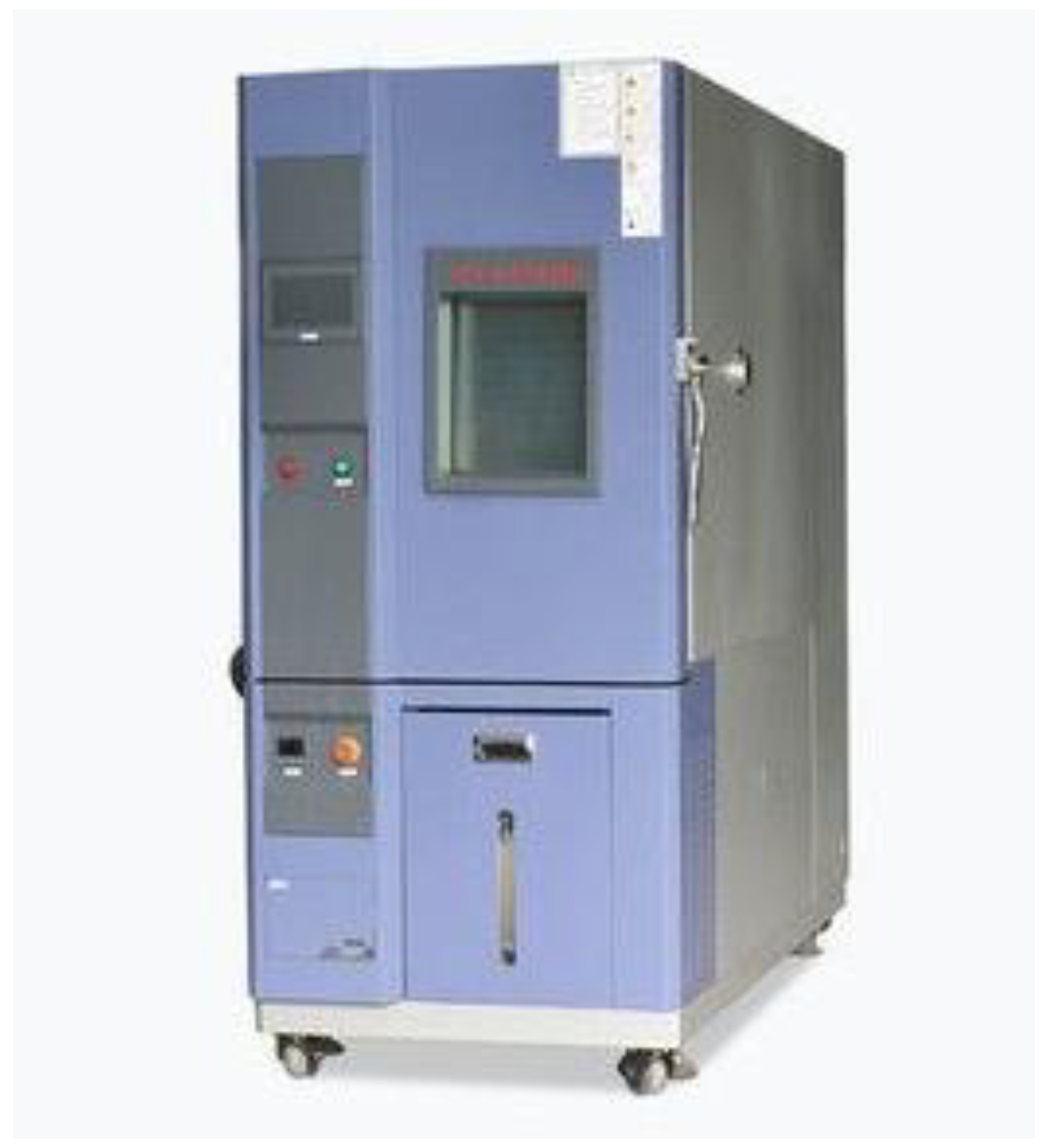
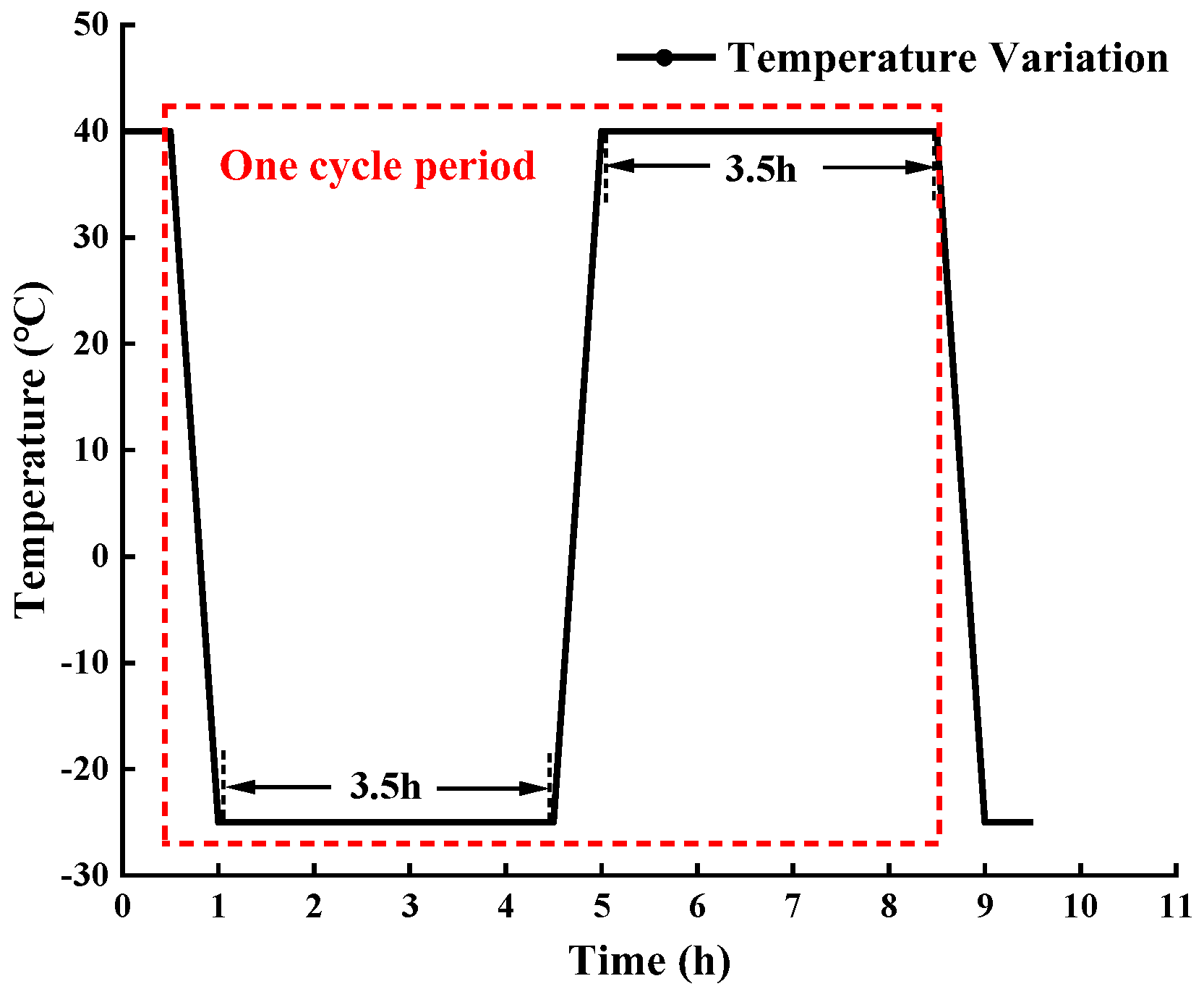



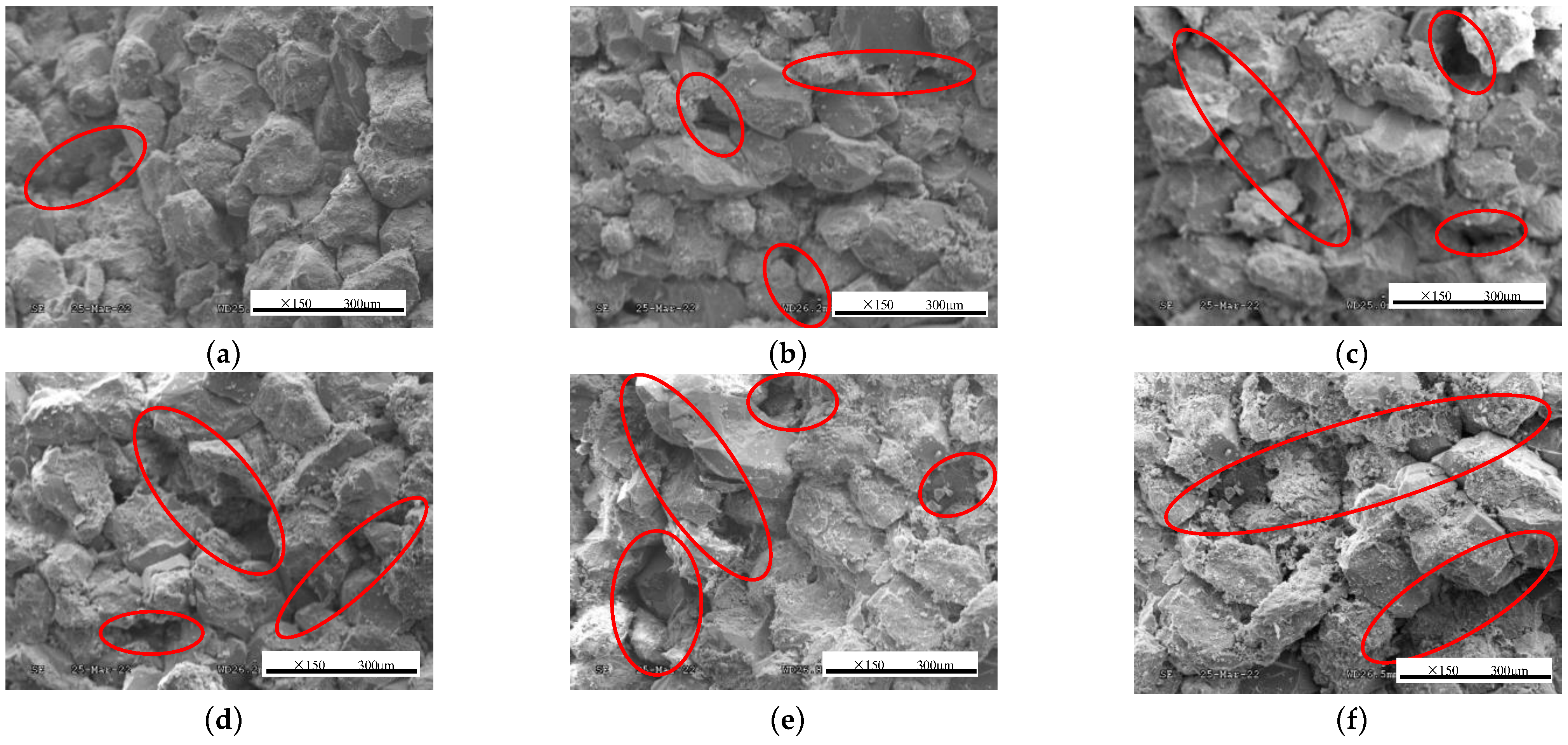
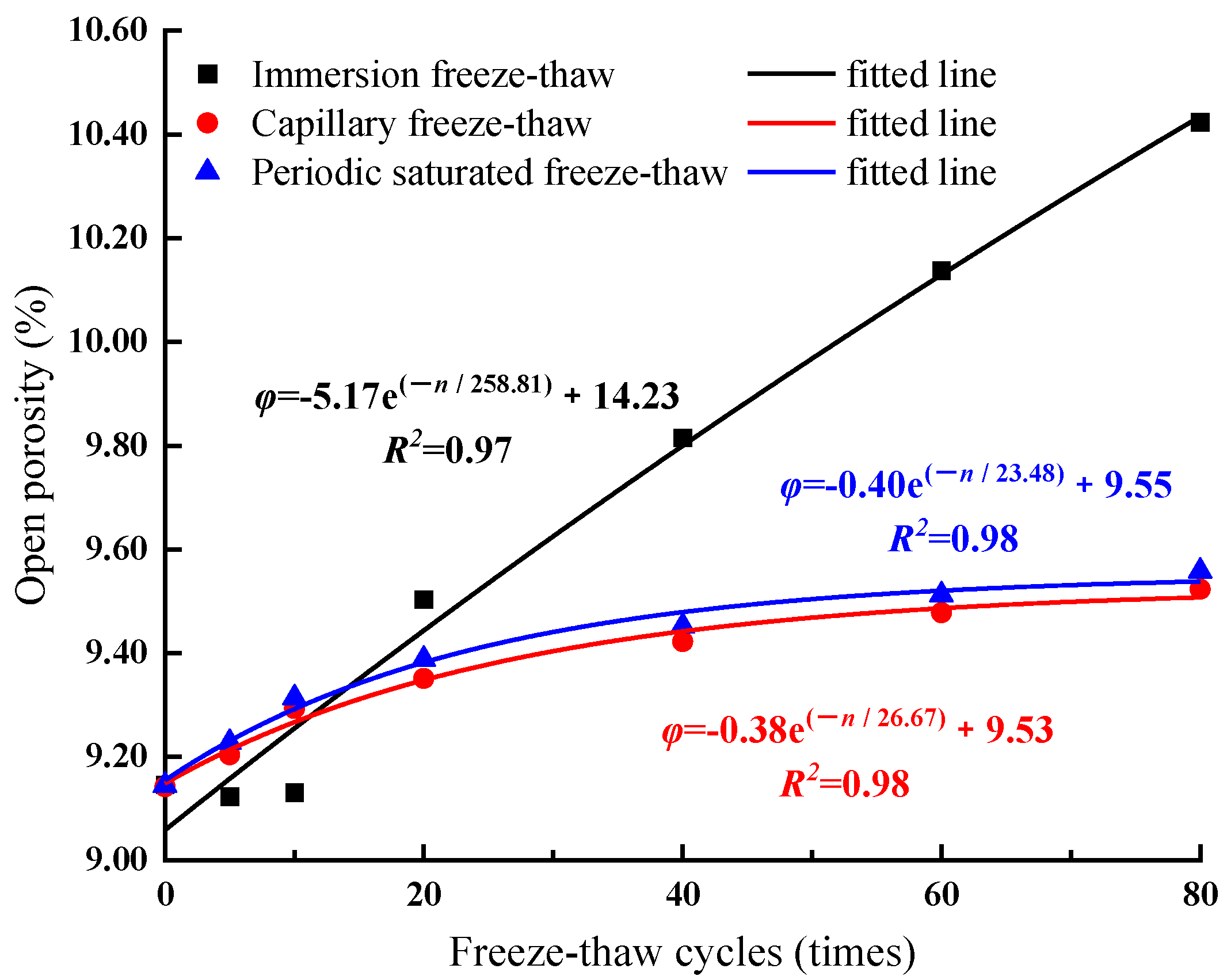
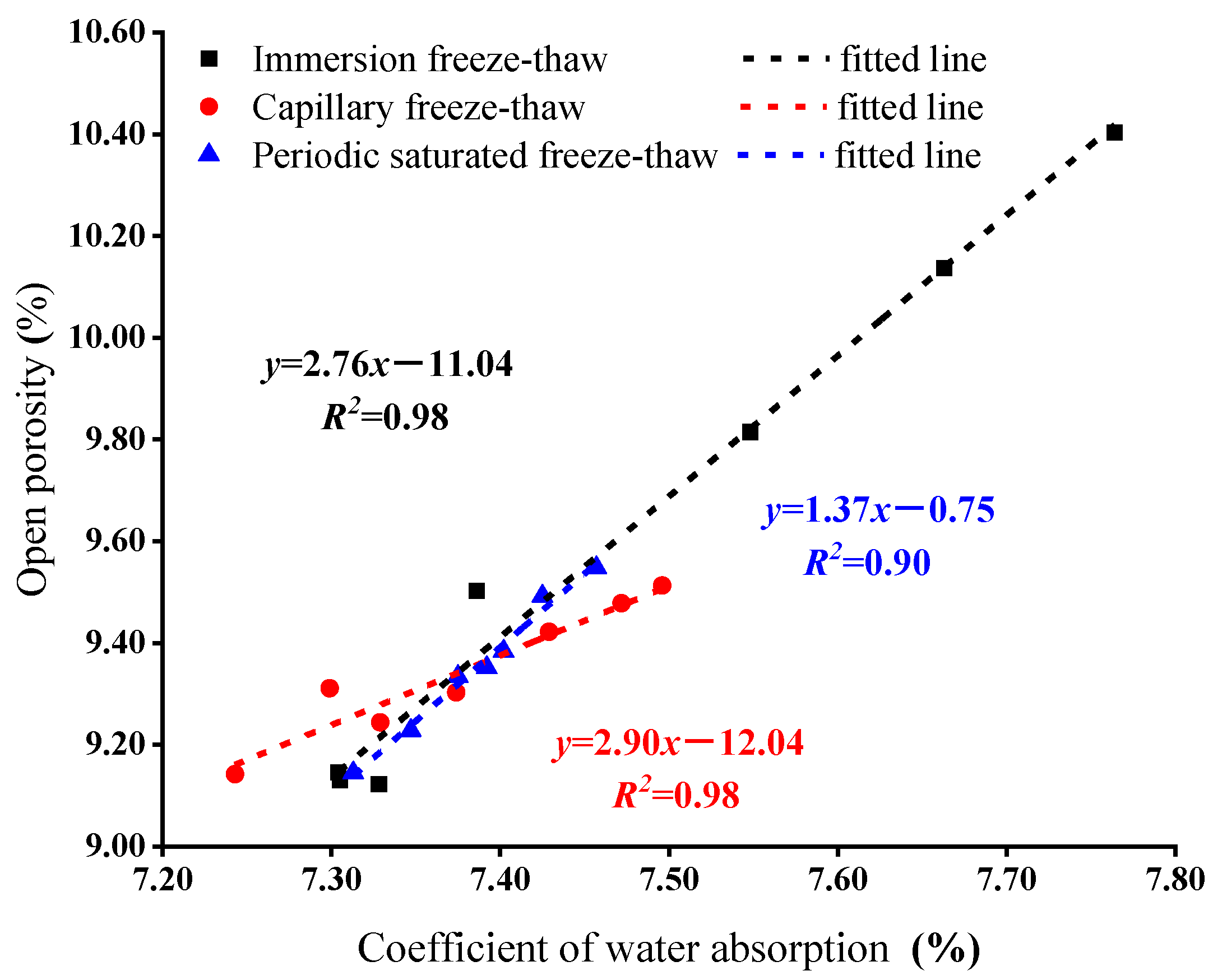

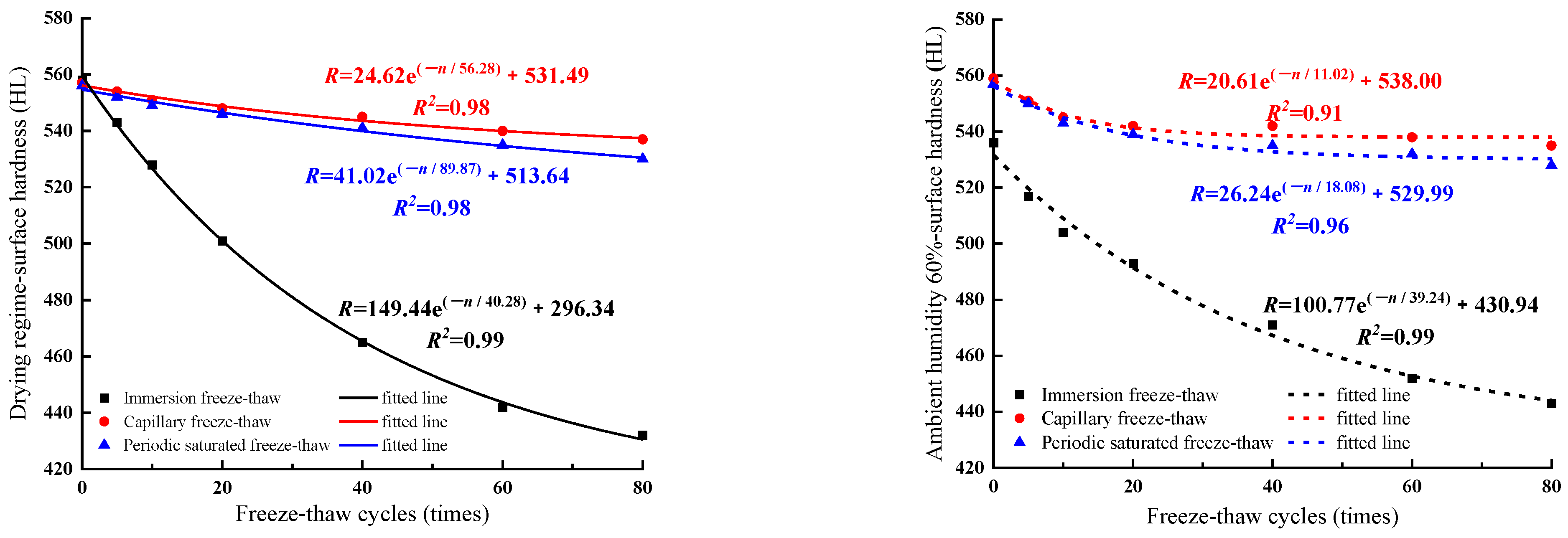
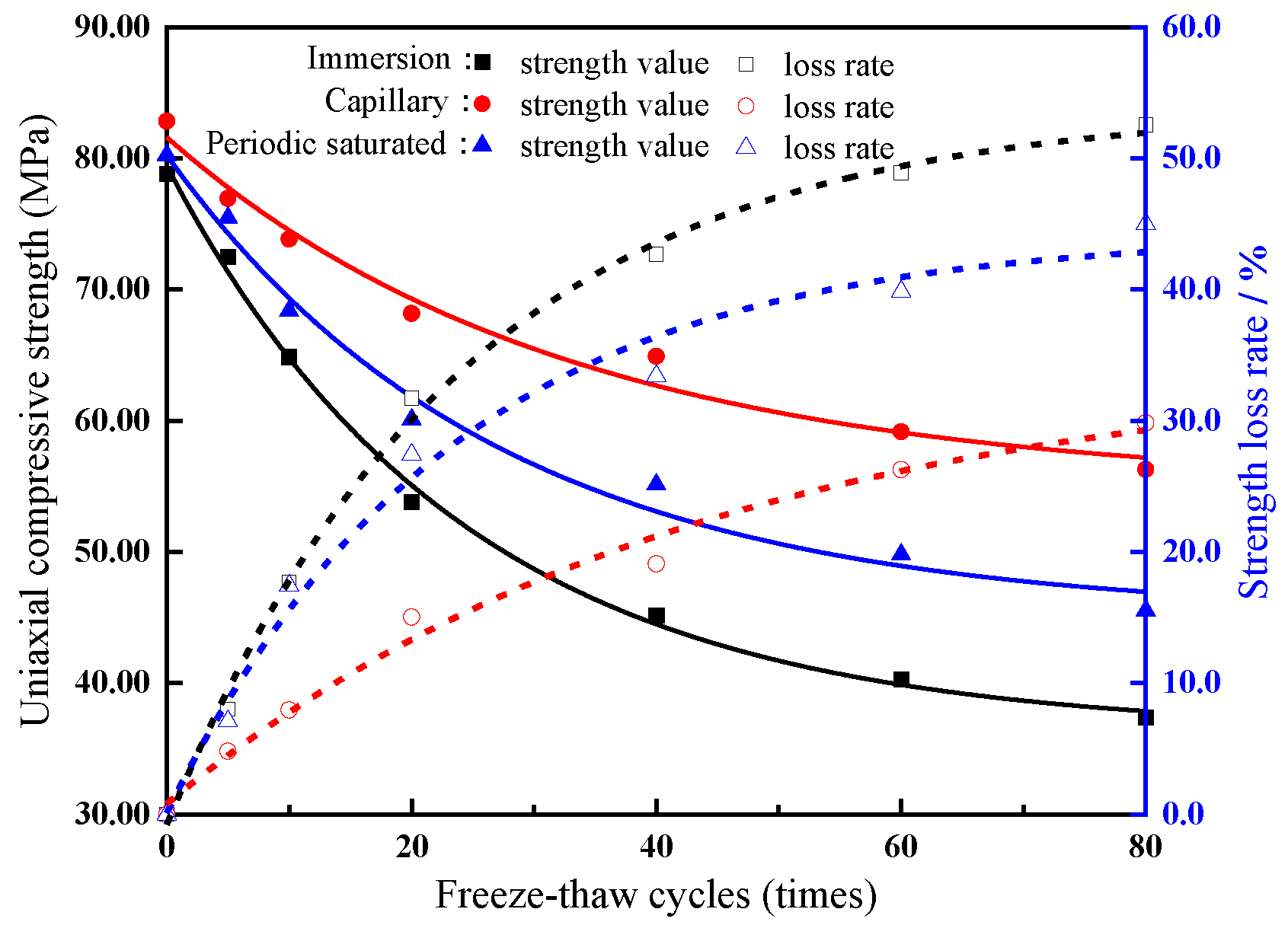
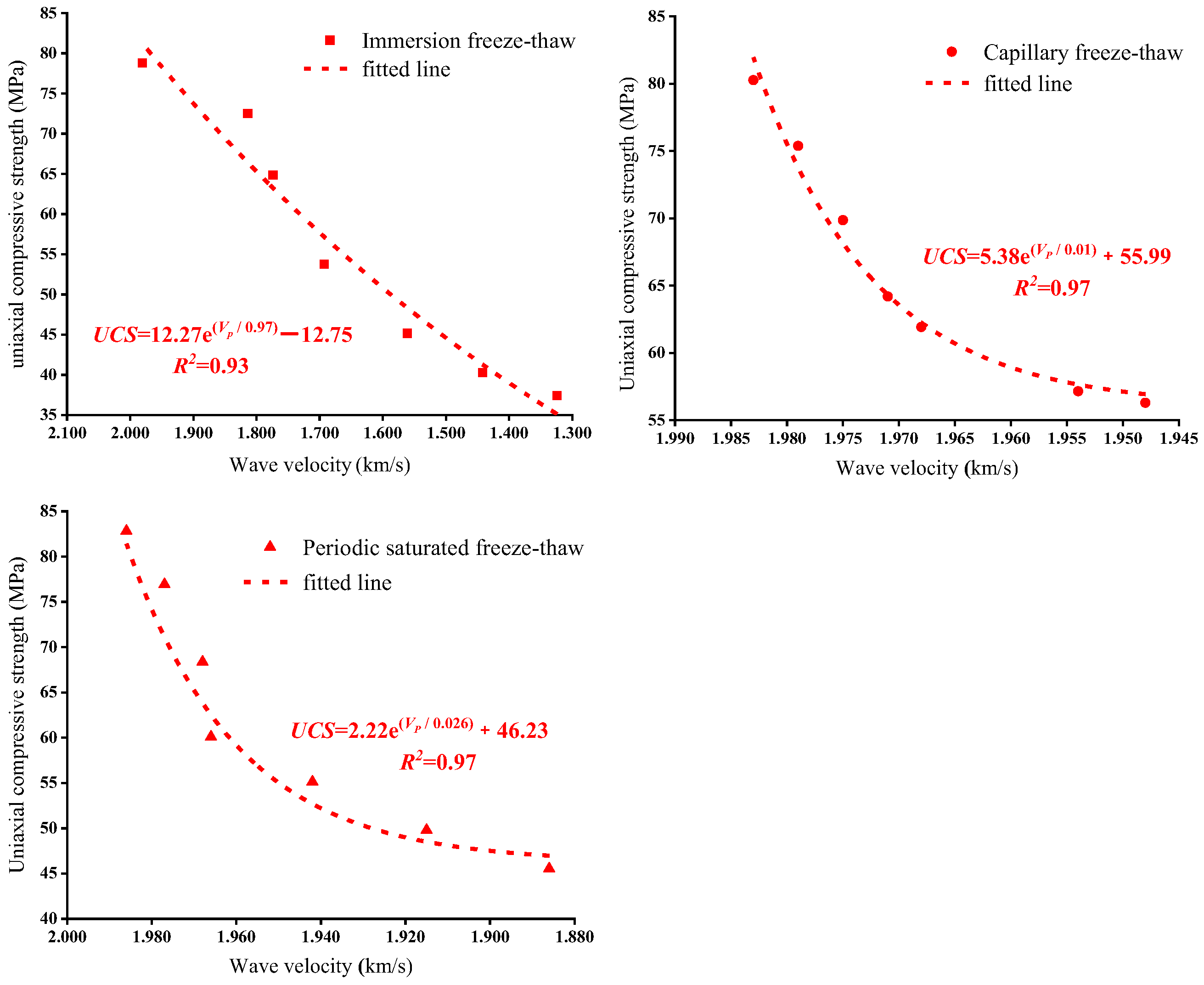
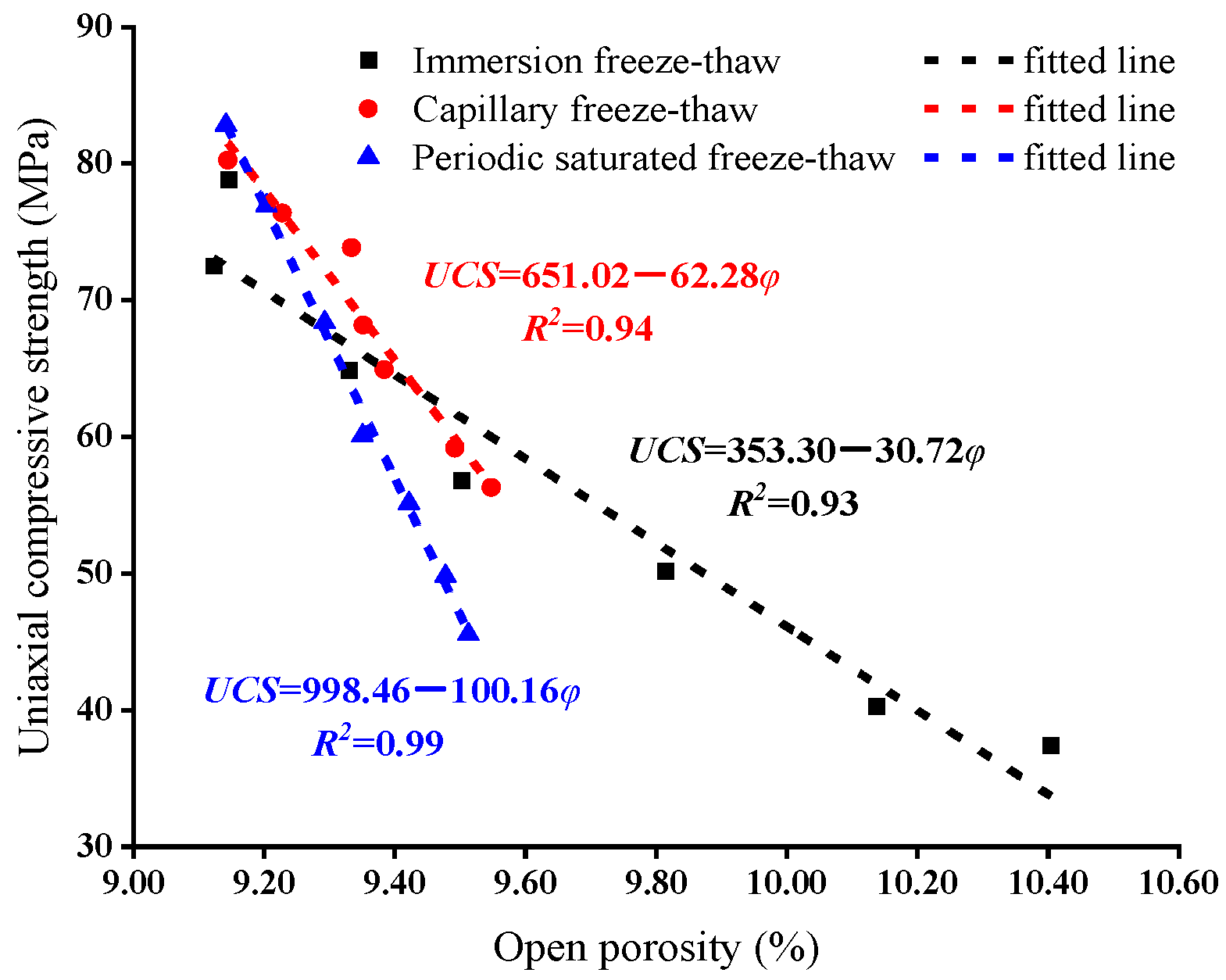
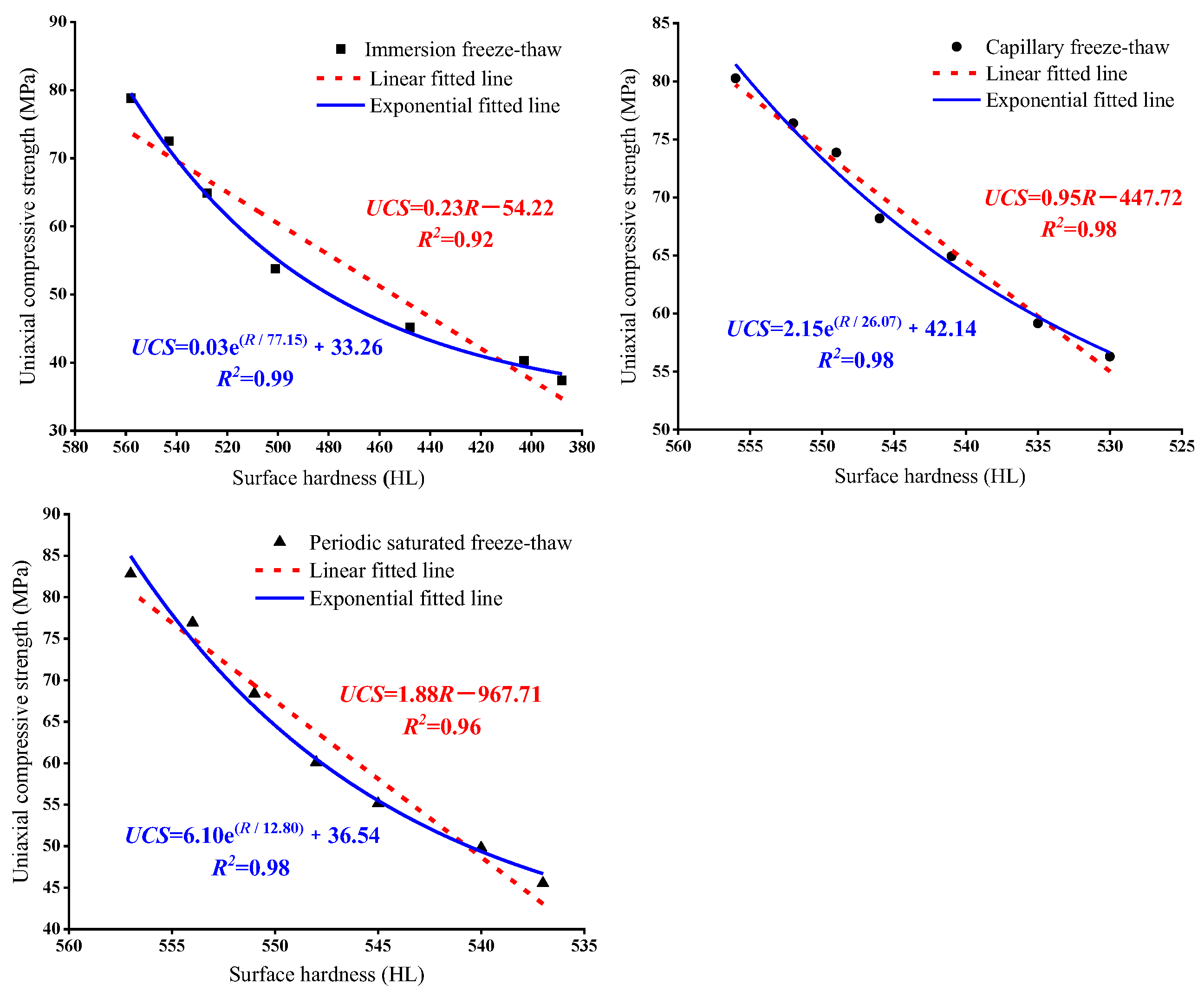
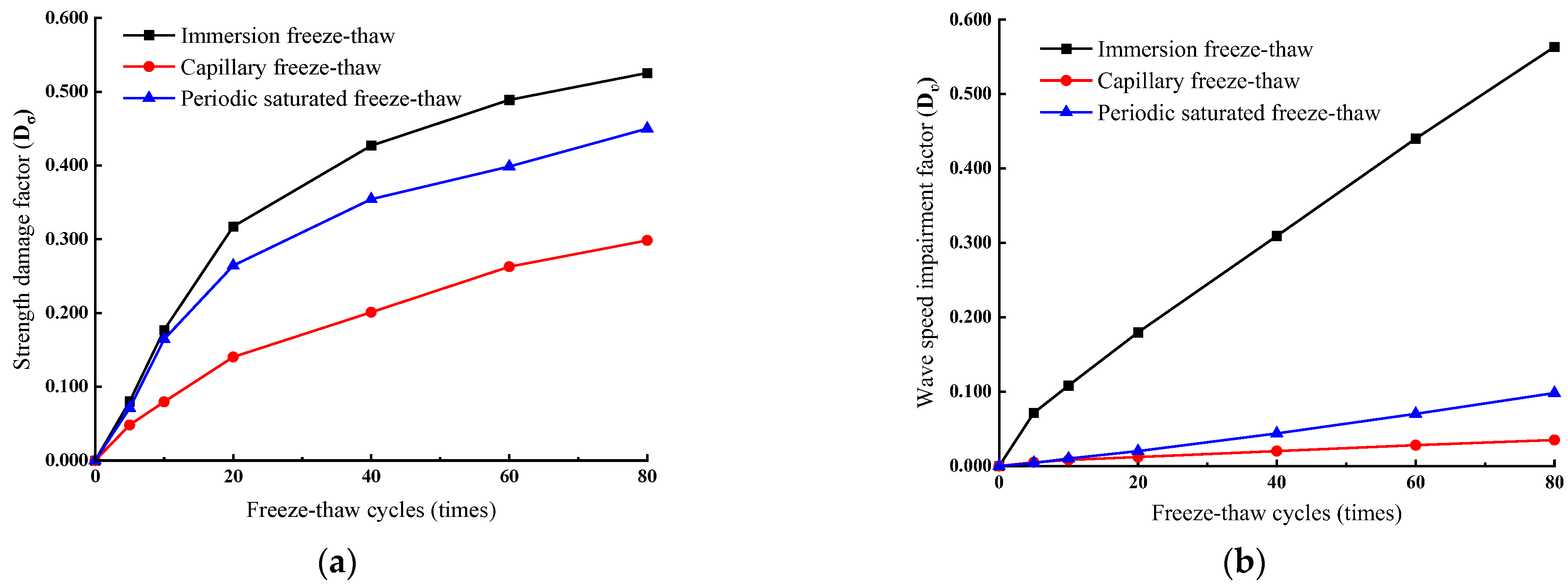

| Freeze–Thaw Cycle/Times | 0 | 5 | 10 | 20 | 40 | 60 | 80 |
|---|---|---|---|---|---|---|---|
| Immersion freeze–thaw | J0-1~J0-7 | J1-1~J1-7 | J2-1~J2-7 | J3-1~J3-7 | J4-1~J4-7 | J5-1~J5-7 | J6-1~J6-7 |
| Capillary freeze–thaw | B0-1~B0-7 | B1-1~B1-7 | B2-1~B2-7 | B3-1~B3-7 | B4-1~B4-7 | B5-1~B5-7 | B6-1~B6-7 |
| Periodic saturation freeze–thaw | R0-1~R0-7 | R1-1~R1-7 | R2-1~R2-7 | R3-1~R3-7 | R4-1~R4-7 | R5-1~R5-7 | R6-1~R6-7 |
| Parameter | Wave Velocity v (km/s) | Natural Water Absorption Wa (%) | Dry Density ρd (g/cm) | Open Porosity φ (%) | Surface Hardness r (HL) | UCS (MPa) |
|---|---|---|---|---|---|---|
| The numerical | 1.986 | 4.321 | 2.311 | 9.145 | 558 | 82.83 |
| Number of Freeze–Thaw Cycles/Times | Intensity Damage Factor/Dσ | Wave Velocity Damage Factor/Dv | ||||
|---|---|---|---|---|---|---|
| Immersion Freeze–Thaw | Capillary Freeze–Thaw | Periodic Saturated Freeze–Thaw | Immersion Freeze–Thaw | Capillary Freeze–Thaw | Periodic Saturated Freeze–Thaw | |
| 0 | 0 | 0 | 0 | 0 | 0 | 0 |
| 5 | 0.081 | 0.049 | 0.162 | 0.162 | 0.005 | 0.004 |
| 10 | 0.177 | 0.080 | 0.175 | 0.198 | 0.008 | 0.010 |
| 20 | 0.318 | 0.151 | 0.275 | 0.271 | 0.012 | 0.044 |
| 40 | 0.427 | 0.191 | 0.335 | 0.379 | 0.021 | 0.044 |
| 60 | 0.489 | 0.263 | 0.399 | 0.471 | 0.028 | 0.071 |
| 80 | 0.526 | 0.299 | 0.451 | 0.554 | 0.035 | 0.099 |
Publisher’s Note: MDPI stays neutral with regard to jurisdictional claims in published maps and institutional affiliations. |
© 2022 by the authors. Licensee MDPI, Basel, Switzerland. This article is an open access article distributed under the terms and conditions of the Creative Commons Attribution (CC BY) license (https://creativecommons.org/licenses/by/4.0/).
Share and Cite
Peng, N.; Hong, J.; Zhu, Y.; Dong, Y.; Sun, B.; Huang, J. Experimental Investigation of the Influence of Freeze–Thaw Mode on Damage Characteristics of Sandstone. Appl. Sci. 2022, 12, 12395. https://doi.org/10.3390/app122312395
Peng N, Hong J, Zhu Y, Dong Y, Sun B, Huang J. Experimental Investigation of the Influence of Freeze–Thaw Mode on Damage Characteristics of Sandstone. Applied Sciences. 2022; 12(23):12395. https://doi.org/10.3390/app122312395
Chicago/Turabian StylePeng, Ningbo, Jie Hong, Ye Zhu, Yun Dong, Bo Sun, and Jizhong Huang. 2022. "Experimental Investigation of the Influence of Freeze–Thaw Mode on Damage Characteristics of Sandstone" Applied Sciences 12, no. 23: 12395. https://doi.org/10.3390/app122312395
APA StylePeng, N., Hong, J., Zhu, Y., Dong, Y., Sun, B., & Huang, J. (2022). Experimental Investigation of the Influence of Freeze–Thaw Mode on Damage Characteristics of Sandstone. Applied Sciences, 12(23), 12395. https://doi.org/10.3390/app122312395






